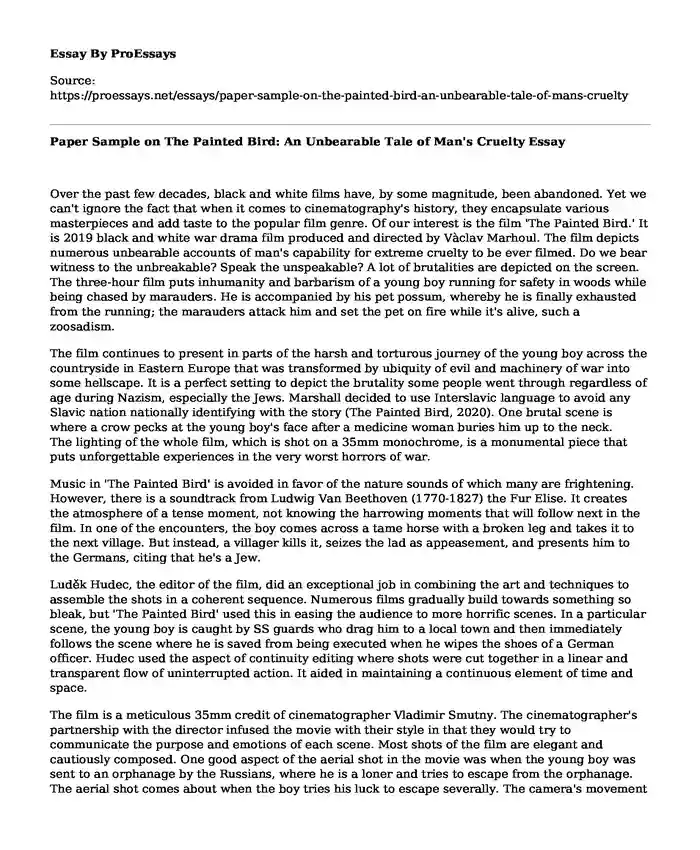Over the past few decades, black and white films have, by some magnitude, been abandoned. Yet we can't ignore the fact that when it comes to cinematography's history, they encapsulate various masterpieces and add taste to the popular film genre. Of our interest is the film 'The Painted Bird.' It is 2019 black and white war drama film produced and directed by Vàclav Marhoul. The film depicts numerous unbearable accounts of man's capability for extreme cruelty to be ever filmed. Do we bear witness to the unbreakable? Speak the unspeakable? A lot of brutalities are depicted on the screen. The three-hour film puts inhumanity and barbarism of a young boy running for safety in woods while being chased by marauders. He is accompanied by his pet possum, whereby he is finally exhausted from the running; the marauders attack him and set the pet on fire while it's alive, such a zoosadism.
The film continues to present in parts of the harsh and torturous journey of the young boy across the countryside in Eastern Europe that was transformed by ubiquity of evil and machinery of war into some hellscape. It is a perfect setting to depict the brutality some people went through regardless of age during Nazism, especially the Jews. Marshall decided to use Interslavic language to avoid any Slavic nation nationally identifying with the story (The Painted Bird, 2020). One brutal scene is where a crow pecks at the young boy's face after a medicine woman buries him up to the neck. The lighting of the whole film, which is shot on a 35mm monochrome, is a monumental piece that puts unforgettable experiences in the very worst horrors of war.
Music in 'The Painted Bird' is avoided in favor of the nature sounds of which many are frightening. However, there is a soundtrack from Ludwig Van Beethoven (1770-1827) the Fur Elise. It creates the atmosphere of a tense moment, not knowing the harrowing moments that will follow next in the film. In one of the encounters, the boy comes across a tame horse with a broken leg and takes it to the next village. But instead, a villager kills it, seizes the lad as appeasement, and presents him to the Germans, citing that he's a Jew.
Ludek Hudec, the editor of the film, did an exceptional job in combining the art and techniques to assemble the shots in a coherent sequence. Numerous films gradually build towards something so bleak, but 'The Painted Bird' used this in easing the audience to more horrific scenes. In a particular scene, the young boy is caught by SS guards who drag him to a local town and then immediately follows the scene where he is saved from being executed when he wipes the shoes of a German officer. Hudec used the aspect of continuity editing where shots were cut together in a linear and transparent flow of uninterrupted action. It aided in maintaining a continuous element of time and space.
The film is a meticulous 35mm credit of cinematographer Vladimir Smutny. The cinematographer's partnership with the director infused the movie with their style in that they would try to communicate the purpose and emotions of each scene. Most shots of the film are elegant and cautiously composed. One good aspect of the aerial shot in the movie was when the young boy was sent to an orphanage by the Russians, where he is a loner and tries to escape from the orphanage. The aerial shot comes about when the boy tries his luck to escape severally. The camera's movement in the aerial shot provides the audience with the opportunity to contemplate what was happening on and off the screen.
It is with no doubt that in glamour cinematography, black and white wins it all. In today's era, directors prefer black and white in making a political and aesthetic point (Gabbard, 2015). Other films are also shot in black and white as a tribute to the earlier cinema genres before colored films came into play. It is also a favorable medium in evoking a sense of the past. 'The Painted Bird' is breathtakingly cinematic, just as discussed in the few graphic scenes in this paper, providing a firm basis that black and white films can give stunning performances. The views are meticulously polished, with the stacked building of evil and inhumanity, each worse than the next.
References
Gabbard, K. (2015). “They Always Get the Best of You Somehow”: Preston Sturges in Black and White. Refocus: The Films of Preston Sturges. doi:10.3366/edinburgh/9781474406550.003.0007.
The Painted Bird. (2020, March 05). Retrieved July 29, 2020, from https://www.imdb.com/title/tt1667354/.
Cite this page
Paper Sample on The Painted Bird: An Unbearable Tale of Man's Cruelty. (2023, Oct 29). Retrieved from https://proessays.net/essays/paper-sample-on-the-painted-bird-an-unbearable-tale-of-mans-cruelty
If you are the original author of this essay and no longer wish to have it published on the ProEssays website, please click below to request its removal:
- Research Paper on Georgian Theatre History
- Toyota Manufacturing Production and Assembly at Toyota Factory and Lean - Video Analysis Essay
- African Grove Theatre Essay
- Essay Sample on Sustainable Bahrain World Trade Center
- Paper Example on Balkans: Colonial Rule & Call for Independence
- War: Not a Justifiable Action Under Any Circumstance - Essay Sample
- Research Paper on Cold War: USSR vs US: Forty Years of Tension







